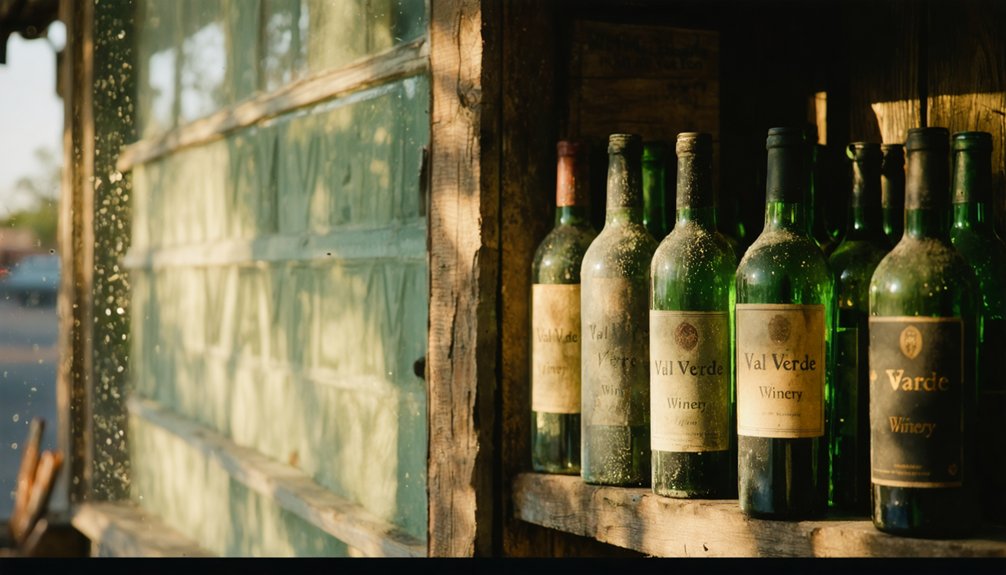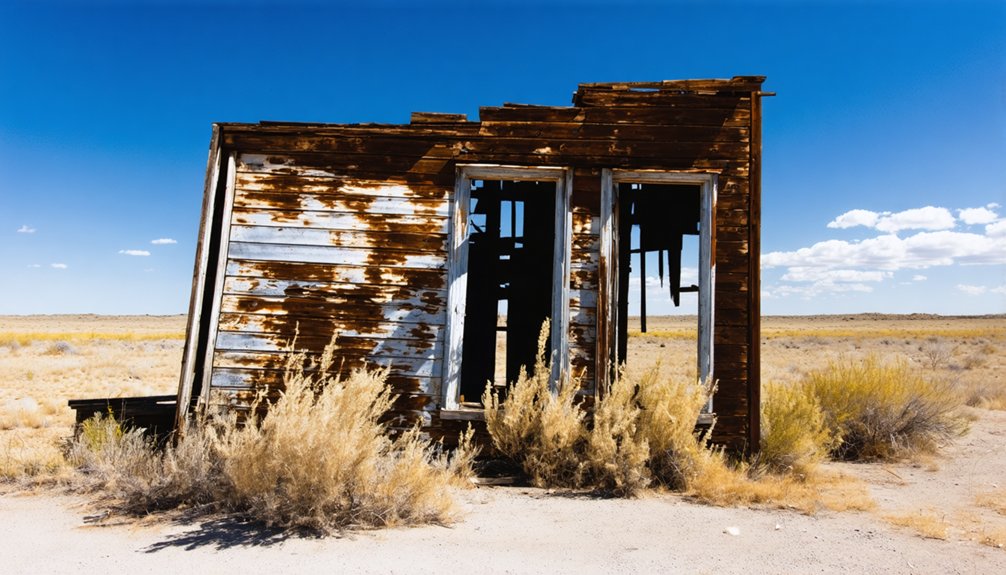You’ll discover Juno as a ghost town along Texas’s Devil’s River, where a frontier settlement once protected settlers from Comanche raids in the 1840s. The town’s unique name emerged from a café owner’s “you know” response, later becoming official with its 1885 post office establishment. Though it thrived as a ranching hub with 80 residents in 1964, Juno’s population dwindled to 10 by 1968, with its last business closing in 1985. The town’s rich history holds countless untold stories.
Key Takeaways
- Juno, Texas transformed from a vibrant ranching community of 80 residents in 1964 to a ghost town with only 10 people by 1968.
- The town’s final decline occurred with the closure of its post office in 1975 and its last operating business in 1985.
- Originally established near Beaver Lake in 1849, Juno served as a crucial supply center for ranchers in the Devil’s River region.
- The town’s unique name originated from a café owner’s pronunciation of “you know,” reflecting the area’s cultural fusion.
- Historic remnants of Juno can still be explored, though visitors should be cautious of sharp blind curves in the area.
The Origin Behind Juno’s Peculiar Name

Frontier humor gave birth to the peculiar name of Juno, Texas, through a casual exchange at Henry Stein’s café in the late 19th century. When customers asked what was on the menu at his establishment, Stein’s simple response of “you know” became phonetically interpreted as “Juno.”
The name’s significance grew as locals embraced this linguistic quirk, eventually making it official when establishing the post office in 1885. This name reflects the cultural blending that characterized West Texas during its formative years. Like the HMS Juno ships that served in the Royal Navy, the town’s name became part of a larger historical legacy.
Stein’s café, known for serving frijoles and beer, embodied the intersection of Anglo and Hispanic influences. The establishment became an important part of the supply center that emerged in the 1880s. You’ll find this unique etymology stands apart from typical Texas town names, which were usually derived from prominent figures or geographic features.
The informal origin story has become a treasured part of local heritage.
From Frontier Settlement to Ranching Hub
While U.S. Army troops established a protective presence near Beaver Lake in 1849, they’d lay the groundwork for Juno’s transformation from wild frontier to thriving ranching community.
You’ll find that their strategic positioning along the Devil’s River helped shield early settlers from Comanche and Apache raids, allowing pioneers to overcome frontier challenges and establish permanent roots. Much like how ancient Roman goddess Juno protected her people, the military presence safeguarded the developing settlement.
Today, travelers must exercise caution on the sharp blind curves as they explore what remains of this historic settlement.
Life in Early 1900s Juno
During the early 1900s, Juno blossomed into an essential ranching supply center that served the surrounding Devil’s River region. You’d find a bustling general store and café that formed the heart of the town’s social dynamics, where ranchers gathered to swap stories and conduct business. Much like the once-thriving port city of Indianola near Galveston, the town played a vital role in Texas development.
The local schoolhouse tackled educational challenges head-on, ensuring children received proper schooling despite the frontier setting. If you’d lived there, you’d have enjoyed modern conveniences like telephone service and a post office established in 1885, connecting you to the outside world.
The community remained tight-knit, with most social activities centered around public buildings. Similar to the preserved site of Old Alton Bridge, only ruins remain of this once-vibrant settlement. By 1964, you’d have been one of about 80 residents in this small but significant ranching community.
The Natural History of Beaver Lake
Located about a mile east of where Texas Highway 163 meets Farm Road 189, Beaver Lake once served as an essential water source and habitat for indigenous peoples and wildlife alike.
The lake’s historical significance stems from its rich Native habitat, supporting Jumano, Comanche, and Kiowa tribes who utilized its abundant resources for millennia. The area became infamous for its intertribal skirmishes as various groups competed for the precious water source.
The lake’s beaver ecology fostered remarkable wildlife diversity, including otters, bears, deer, and longhorn cattle. You’d have found this natural oasis teeming with game species vital for both Native American sustenance and early settler economies. The lake’s clear spring-fed waters created ideal conditions for various native fish species.
The Final Years and Modern Legacy
Just as Beaver Lake’s waters gradually receded into history, Juno’s significance as a community began to fade in the mid-1960s.
You’ll find that the town’s population plummeted from 80 residents in 1964 to merely 10 by 1968, marking the onset of economic stagnation that would seal its fate.
The U.S. Army originally stationed troops at Beaver Lake in 1849 to protect travelers passing through the region.
The closure of Juno’s post office in 1975 and its last business in 1985 effectively transformed this once-vital ranching supply center into a ghost town, much like how modern oil usage caused the decline of coal-mining towns.
With its post office and final business shuttered, Juno faded from a bustling ranch hub into an empty testament of time.
While its physical presence has largely vanished, Juno’s cultural significance endures through its unique name origin – derived from a café owner’s catchphrase “Ju know” – and its role in the Law West of the Pecos heritage.
Today, you’ll discover Juno’s legacy preserved in ghost town tours and historical accounts of West Texas’s rural transformation.
Frequently Asked Questions
What Were the Most Common Ranch Animals Raised Around Juno?
Like kings of the prairie, cattle dominated ranching operations, with horses essential for working them. You’d also find sheep herding ventures and some goat raising, though in smaller numbers.
Did Any Famous Outlaws or Historical Figures Ever Pass Through Juno?
You won’t find any confirmed outlaw sightings or historical legends of famous figures in this town. While Davy Crockett inspired the county’s name, there’s no evidence he or other notables visited.
How Did Residents Get Their Drinking Water in Juno?
You’d find your water from multiple sources – Beaver Lake’s cool depths, community wells, natural springs, and even rainwater catchment systems. When Beaver Lake vanished mid-century, you’d rely more on groundwater wells.
What Was the Average Price of Land in Juno During Its Peak?
You’d find land values during peak economic growth ranged from $2-4 per acre, though exact records aren’t preserved. This estimate’s based on comparable Texas ghost towns and regional pricing patterns.
Were There Any Churches or Religious Gatherings in Juno’s History?
Through detailed records, you won’t find evidence of church history or religious significance in Juno. While nearby ghost towns had churches, no documented churches or formal religious gatherings existed here.
References
- https://en.wikipedia.org/wiki/Juno
- https://kids.kiddle.co/Juno
- https://www.ozona.com/the-ghost-town-of-juno
- https://www.ozona.com/old-juno-road-itinerary
- https://en.wikipedia.org/wiki/List_of_ghost_towns_in_Texas
- https://www.texasescapes.com/WestTexasTowns/JunoTexas/JunoTx.htm
- https://texashighways.com/travel-news/four-texas-ghost-towns/
- https://www.tshaonline.org/handbook/entries/yuno-tx
- https://www.tshaonline.org/handbook/entries/juno-tx
- https://www.youtube.com/watch?v=Y0__p2rhMMc



